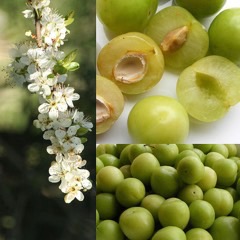 |
|
Agnieszka Kwiecien, Nova wikimedia.org |
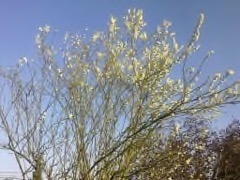 |
| VerboseDreamer wikimedia.org |
Translate this page:
Summary
Greengage (P. domestica subsp. italica) cultivars of the European plum. They are often considered the finest of the dessert plums and have a delicious flavour. The green, globose fruit is usually 30-40mm (1.5in) in diameter. Flowers are edible, used as a garnish for salads and ice cream, or brewed into tea. Greengages are of excellent quality, though their delicate skins make it challenging to get them to market in good condition.
The genus Prunus includes deciduous or evergreen shrubs and trees with showy spring flowers and good autumn leaf colour; some have attractive ornamental bark. Prunus includes several species developed for fruit and nut production, such as apricots, cherries, peaches, nectarines, almonds, and plums. Other species are useful in food forests for their seed and fruit. Most edible fruit from this genus is eaten raw, cooked or dried for later use. Seeds are edible, but if they are bitter, eat them in strict moderation. Several Prunus species will succeed in light shade but fruit better in a sunny position. The seeds of all members of this genus could be used for oil extraction. The extracted oil is semi-drying. Consume in small quantities if it tastes strongly of bitter almonds. Most genus members are shallow-rooted, forming a plate near the soil surface, and will produce suckers if the roots are damaged.
Physical Characteristics

 Prunus domestica italica is a deciduous Tree growing to 5 m (16ft) by 4 m (13ft) at a medium rate.
Prunus domestica italica is a deciduous Tree growing to 5 m (16ft) by 4 m (13ft) at a medium rate.
See above for USDA hardiness. It is hardy to UK zone 6. The flowers are pollinated by Bees, Insects. The plant is self-fertile.
It is noted for attracting wildlife.
Suitable for: light (sandy), medium (loamy) and heavy (clay) soils, prefers well-drained soil and can grow in heavy clay soil. Suitable pH: mildly acid, neutral and basic (mildly alkaline) soils and can grow in very alkaline soils.
It can grow in semi-shade (light woodland) or no shade. It prefers moist soil.
UK Hardiness Map
US Hardiness Map
Synonyms
P. domestica subsp. italica. P. italica Borkh.
Plant Habitats
Edible Uses
Edible Parts: Flowers Fruit Oil Seed
Edible Uses: Oil
Fruit - raw or cooked. Often considered to be the finest of the dessert plums, they have a delicious flavour[K ].The greengages. The usually green, globose fruit is usually 30 - 400mm in diameter. Seed - raw or cooked. Do not eat the seed if it is too bitter - see the notes above on toxicity. An edible gum is obtained from points of damage on the trunk[64 ]. The seed contains about 20% of an edible semi-drying oil[4 , 57 ]. It has an agreeable almond smell and flavour[4 ]. The flowers are eaten. They are used as a garnish for salads and ice cream or brewed into a tea[183 ].
References More on Edible Uses
Medicinal Uses
Plants For A Future can not take any responsibility for any adverse effects from the use of plants. Always seek advice from a professional before using a plant medicinally.
Digestive Febrifuge Laxative Purgative Stomachic Styptic
The dried fruit, known as prunes, is a safe and effective laxative and is also stomachic [4 , 7 , 21 , 238 ]. The bark is sometimes used as a febrifuge and is styptic [4 , 7 ]. An infusion of the flowers has been used as a mild purgative for children [4 ]. Although no specific mention has been seen for this species, all members of the genus contain amygdalin and prunasin, substances which break down in water to form hydrocyanic acid (cyanide or prussic acid). In small amounts this exceedingly poisonous compound stimulates respiration, improves digestion and gives a sense of well-being [238 ].
References More on Medicinal Uses
The Bookshop: Edible Plant Books
Our Latest books on Perennial Plants For Food Forests and Permaculture Gardens in paperback or digital formats.
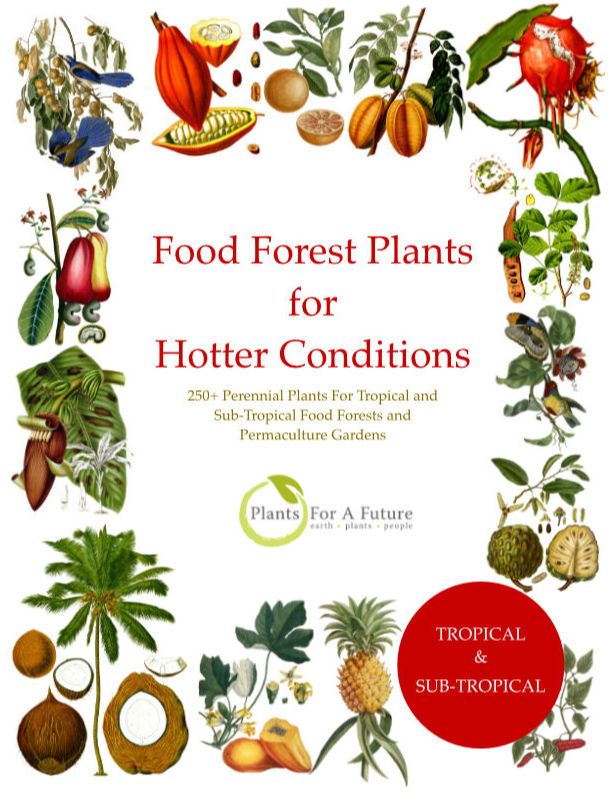
Edible Tropical Plants
Food Forest Plants for Hotter Conditions: 250+ Plants For Tropical Food Forests & Permaculture Gardens.
More
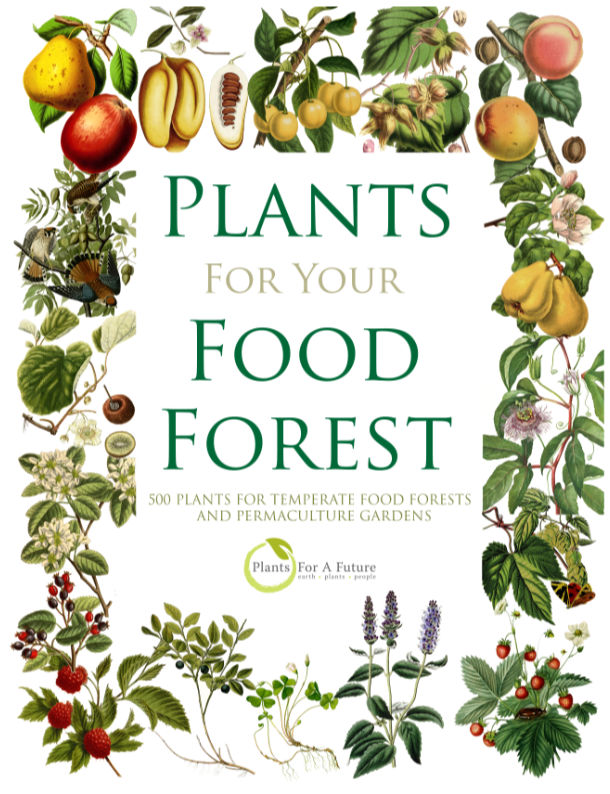
Edible Temperate Plants
Plants for Your Food Forest: 500 Plants for Temperate Food Forests & Permaculture Gardens.
More
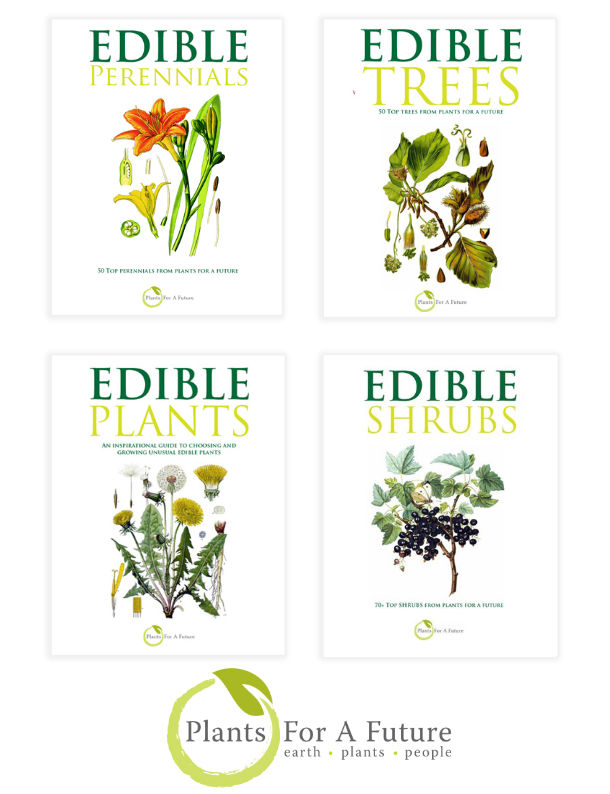
More Books
PFAF have eight books available in paperback and digital formats. Browse the shop for more information.
Shop Now
Other Uses
Adhesive Cosmetic Dye Oil Wood
Agroforestry uses:
Prunus species can be used as windbreaks and in alley cropping systems. They also improve biodiversity by providing habitats for pollinators and other wildlife. Some varieties can fix nitrogen in the soil, contributing to soil health.
A green dye can be obtained from the leaves [168 ]. A dark grey to green dye can be obtained from the fruit [168 ]. A yellow dye is obtained from the bark [115 ]. A gum obtained from points of damage along the stem can be used as an adhesive [64 ]. The ground up seeds are used cosmetically in the production of face-masks for dry skin [7 ]. A semi-drying oil is obtained from the seed [64 ]. No details of its uses. The reddish-brown wood is very close-grained, hard, compact. Liable to warp and split. It is used for musical instruments [115 , 146 ]. 1. Nectary - Flowers rich in nectar and pollen:
Yes – Prunus species are known for their showy flowers that produce both nectar and pollen, attracting bees, butterflies, and other pollinators.,, which produce and attract
2. Wildlife - Food (Fruit, Seeds, Leaf litter, Shelter, Nesting, Roosting):
Yes – The fruits are an important food source for birds and mammals, and the trees provide shelter through their dense foliage. Some species, especially cherries and plums, are known to support wildlife with both food and roosting/nesting sites.
3. Invertebrate Shelter (Overwintering sites, Leaf litter, Groundcover):
Yes – Prunus species offer shelter for invertebrates, particularly in their rough bark and leaf litter. They also support beneficial insects by providing overwintering sites.
4. Pest Confuser (Smell):
No – While Prunus species are fragrant when blooming, they are not known for emitting strong pest-repelling scents.
Special Uses
Food Forest
References More on Other Uses
Cultivation details
The greengages are a group of cultivars of the common European plum. Gages are often cultivated as a fruit crop, especially in western Europe. Of excellent quality, though their delicate skins makes it difficult to get them to market in good condition and so they are more likely to be grown on a garden scale or be used for canning etc. Prunus domestica subsp. italica requires a well-drained moisture retentive soil [1 , 11 ]. Succeeds in light shade but fruits better in a sunny position [11 , 200 ]. Thrives in a loamy soil, doing well on limestone [11 ]. Grows well in heavy clay soils. Prefers some chalk in the soil but apt to become chlorotic if too much is present [1 ]. The various gages are often cultivated for their edible fruits, especially on a garden scale. There are some named varieties [200 ]. The gage was first developed from the plum in the Middle East, later spreading via France into much of western Europe. Its cultivation has spread into most temperate regions, though it is often only grown on a small scale because of the difficulty of getting it to market in good condition. Most members of this genus are shallow-rooted and will produce suckers if the roots are damaged [238 ]. Plants in this genus are notably susceptible to honey fungus [200 ]. In garden design, as well as the above-ground architecture of a plant, root structure considerations help in choosing plants that work together for their optimal soil requirements including nutrients and water. The root pattern is flat with shallow roots spreading near the soil surface [2-1]. Prunus domestica italica is a deciduous shrub or a tree usually growing 2 - 6 metres tall, occasionally to 15 metres. We can infer from its cultivation that the species grows optimally in areas with cold winters and long warm summers as vernalisation is required for flowering. The species can tolerate frost, however, when this occurs after flowering the fruit quality is poor (Lim 2002). Widely grown cultivars include: Boddarts Reneclode (Germany), Bryanston (UK), Cambridge Gage (UK), Canerik (Turkey), Denniston's Superb (USA), Gojeh Sabz (Iran), Yasil Alça or Göy Alça (Azerbaijan), Golden Transparent (UK), Graf Althanns Reneklode (Germany), Green Vanilla (Mount Pelion, Greece), Große Grüne Reneklode (Germany) / Reine Claude Verte (France), Laxton's Gage (UK), Laxton's Supreme (UK), Meroldts Reneclode (Germany), Rainha Cláudia (Portugal), Regina Claudia (Italy), Reine Claude de Bavay (France), Reine Claude d'Oullins (France), Uhinks Reneklode (Germany), Washington (USA). Harvesting typically occurs in late summer to early autumn, with specific timing varying by species. For instance, plums and peaches are usually harvested from July to September (Northern Hemisphere), while almonds are harvested in August to September (Northern Hemisphere).
Prunus species usually flower in early spring, often between March and April (Northern Hemisphere), depending on the species and local climate. Growth rates vary among species, but generally, Prunus trees can grow moderately fast, often reaching full height in 3 to 5 years. However, they may take several years to bear fruit, depending on the species and growing conditions. Some Prunus species (like many plums and almonds) are self-fertile, while others (like sweet cherries and certain apricots) require cross-pollination with another compatible variety for optimal fruit set.
References Carbon Farming Information and Carbon Sequestration Information
Temperature Converter
Type a value in the Celsius field to convert the value to Fahrenheit:
Fahrenheit:
The PFAF Bookshop
Plants For A Future have a number of books available in paperback and digital form. Book titles include Edible Plants, Edible Perennials, Edible Trees,Edible Shrubs, Woodland Gardening, and Temperate Food Forest Plants. Our new book is Food Forest Plants For Hotter Conditions (Tropical and Sub-Tropical).
Shop Now
Plant Propagation
Seed - requires 2 - 3 months cold stratification and is best sown in a cold frame as soon as it is ripe [200 ]. Sow stored seed in a cold frame as early in the year as possible [200 ]. Protect the seed from mice etc. The seed can be rather slow, sometimes taking 18 months to germinate [113 ]. Prick out the seedlings into individual pots when they are large enough to handle. Grow them on in a greenhouse or cold frame for their first winter and plant them out in late spring or early summer of the following year. The various cultivars of plum are unlikely to breed true (though the green forms of the gage generally do) - they will usually produce a range of plants from seed with differing characteristics from their parent, Cuttings of half-ripe wood with a heel, mid summer in a frame [11 , 200 ]. Softwood cuttings from strongly growing plants in spring to early summer in a frame [200 ]. Layering in spring.
Other Names
If available other names are mentioned here
Gages (greengages, round plums etc.; including sspp. claudiana and rotunda)
Native Range
TEMPERATE ASIA: Turkey. EUROPE: Turkey,
Weed Potential
Right plant wrong place. We are currently updating this section.
Please note that a plant may be invasive in one area but may not in your area so it's worth checking.
None Known
Conservation Status
IUCN Red List of Threatened Plants Status : Unknown

| Related Plants
|
| Latin Name | Common Name | Habit | Height | Hardiness | Growth | Soil | Shade | Moisture | Edible | Medicinal | Other |
| Prunus africana | Pygeum | Tree | 18.0 |
10-12
| F | LM | N | M | 0 | 5 | 2 |
| Prunus alabamensis | Alabama Cherry | Tree | 8.0 |
-
| | LMH | SN | M | 2 | 1 | 1 |
| Prunus alleghaniensis | Allegheny Plum, Davis' plum | Tree | 3.5 |
4-8
| F | LMH | SN | M | 3 | 1 | 2 |
| Prunus americana | American Plum, American Wild Plum, Wild Plum | Tree | 6.0 |
3-8
| M | LMH | SN | M | 3 | 2 | 3 |
| Prunus americana lanata | | Tree | 10.0 |
3-7
| | LMH | SN | M | 3 | 1 | 2 |
| Prunus andersonii | Desert Peach | Shrub | 1.8 |
-
| | LMH | SN | M | 2 | 2 | 1 |
| Prunus angustifolia | Chickasaw Plum, Watson's plum, Hally Jolivette Cherry | Tree | 3.0 |
5-9
| M | LMH | SN | M | 3 | 1 | 3 |
| Prunus angustifolia watsonii | Sand Plum | Shrub | 3.0 |
5-9
| | LMH | SN | M | 4 | 1 | 2 |
| Prunus apetala | Clove Cherry | Shrub | 7.0 |
-
| | LMH | SN | M | 2 | 1 | 1 |
| Prunus arabica | | Shrub | 0.0 |
-
| | LMH | SN | DM | 2 | 1 | 2 |
| Prunus armeniaca | Apricot | Tree | 9.0 |
5-7
| M | LM | SN | M | 4 | 3 | 4 |
| Prunus armeniaca mandschurica | Manchurian apricot | Tree | 6.0 |
3-9
| M | LM | SN | M | 4 | 3 | 3 |
| Prunus avium | Wild Cherry, Sweet cherry | Tree | 18.0 |
3-7
| F | LMH | SN | M | 4 | 2 | 4 |
| Prunus besseriana | Dwarf Almond | Tree | 0.0 |
-
| | LMH | SN | M | 2 | 1 | 2 |
| Prunus besseyi | Western Sand Cherry | Shrub | 1.2 |
3-6
| M | LMH | SN | M | 4 | 1 | 2 |
| Prunus bifrons | | Shrub | 1.8 |
-
| | LMH | SN | M | 2 | 1 | 1 |
| Prunus bokharensis | Bokhara Plum | Tree | 0.0 |
-
| | LMH | SN | M | 2 | 1 | 1 |
| Prunus brigantina | Briançon Apricot | Tree | 6.0 |
6-9
| M | LMH | SN | DM | 4 | 1 | 3 |
| Prunus buergeriana | | Tree | 9.0 |
4-8
| | LMH | SN | M | 2 | 1 | 1 |
| Prunus campanulata | Taiwan Cherry | Tree | 7.0 |
7-9
| M | LMH | SN | M | 2 | 1 | 1 |
| Prunus canescens | Greyleaf Cherry | Shrub | 3.0 |
5-9
| | LMH | SN | M | 3 | 1 | 2 |
| Prunus capsica | | Tree | 0.0 |
-
| | LMH | SN | M | 2 | 1 | 1 |
| Prunus caroliniana | American Cherry Laurel, Carolina laurelcherry, Laurel Cherry, | Shrub | 12.0 |
7-10
| F | LMH | SN | DM | 2 | 1 | 3 |
| Prunus cerasifera | Cherry Plum, Myrobalan Plum, Newport Cherry Plum, Pissard Plum | Tree | 9.0 |
5-8
| M | LMH | SN | M | 4 | 1 | 3 |
| Prunus cerasifera divaricata | | Tree | 10.0 |
4-8
| | LMH | SN | M | 4 | 1 | 1 |
| Prunus cerasoides | Wild Himalayan Cherry | Tree | 30.0 |
7-10
| | LMH | SN | M | 2 | 2 | 2 |
| Prunus cerasus | Sour Cherry | Tree | 6.0 |
3-7
| | LMH | SN | M | 1 | 2 | 3 |
| Prunus cerasus austera | Morello Cherry | Tree | 9.0 |
3-7
| | LMH | SN | M | 3 | 1 | 3 |
| Prunus cerasus caproniana | Kentish Red Cherry | Tree | 9.0 |
3-7
| | LMH | SN | M | 3 | 1 | 3 |
| Prunus cerasus frutescens | Bush Sour Cherry | Tree | 1.0 |
3-7
| | LMH | SN | M | 3 | 1 | 3 |
|
|
Growth: S = slow M = medium F = fast. Soil: L = light (sandy) M = medium H = heavy (clay). pH: A = acid N = neutral B = basic (alkaline). Shade: F = full shade S = semi-shade N = no shade. Moisture: D = dry M = Moist We = wet Wa = water.
Now available:
Food Forest Plants for Mediterranean Conditions
350+ Perennial Plants For Mediterranean and Drier Food Forests and Permaculture Gardens.
[Paperback and eBook]
This is the third in Plants For A Future's series of plant guides for food forests tailored to
specific climate zones. Following volumes on temperate and tropical ecosystems, this book focuses
on species suited to Mediterranean conditions—regions with hot, dry summers and cool, wet winters,
often facing the added challenge of climate change.
Read More
Expert comment
Author
(Borkh.) Gams
Botanical References
Links / References
For a list of references used on this page please go here
A special thanks to Ken Fern for some of the information used on this page.
Readers comment
| Add a comment |
|
If you have important information about this plant that may help other users please add a comment or link below. Only comments or links that are felt to be directly relevant to a plant will be included. If you think a comment/link or information contained on this page is inaccurate or misleading we would welcome your feedback at [email protected]. If you have questions about a plant please use the Forum on this website as we do not have the resources to answer questions ourselves.
* Please note: the comments by website users are not necessarily those held by PFAF and may give misleading or inaccurate information.
To leave a comment please Register or login here All comments need to be approved so will not appear immediately.
|
Subject : Prunus domestica italica
|
|
|
|